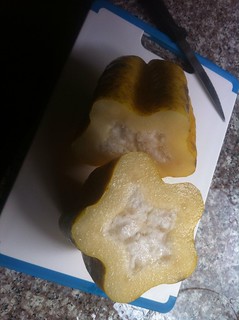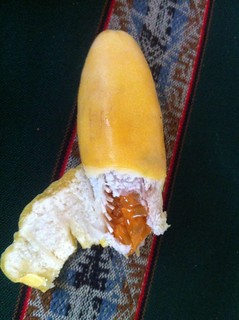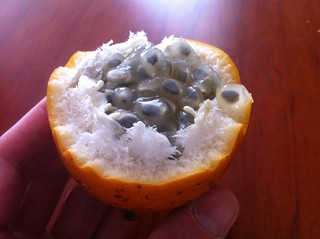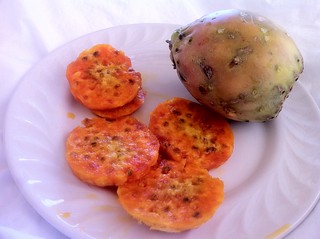South American fruit is
an esoteric world where the wise man treads carefully. Think of it
like the game Minesweeper, random clicking only ends in tears, but
cautious footsteps reveal the hidden horrors (and occasional gems)
without losing a figurative leg (or a literal stomach lining). This
list is a work in progress and – of course – totally subjective
from the perspective of a confused European.
 |
| South American fruit... it's a minefield |
The Good
* Babaco – Love at
first sight. It has a green, waxy skin that yellows as the fruit
ripens. There's a satisfying plumpness about a babaco, just holding
one compels a powerful urge to smash this swollen monster into
smithereens of pulpy juice... and if it didn't taste so good I'd have
succumbed to temptation long ago.
The babaco has a
star shape that makes it hard to peel, but it's well worth the
effort. Inside is an overflowing juice factory (so make sure you've
got a bowl handy to catch the liquid while you're skinning the
fruit).
The flesh is slightly
sour but a spoonful of sugar takes the edge off the tang. The fruit
soaks up the sugar and you have the most delicious breakfast since
man first topped a soft-boiled egg and served it with a platter of
soldiers.
Tasting notes: a
bouquet of peach, with low melon notes and a subtle citrus tang
 |
| What a star |
 |
| Dulce de Babaco - ready to eat |
Uvilla – You might
know these by as Physalis Peruviana or Chinese Lanterns? Anyway, I
snacked on these straight from a bush in El Tingo and – warmed
under a midday sun – they were delicious. They come ready wrapped
in lace-like parcels, so every fruit feels like Christmas morning.
Tasting notes: subtle
floral notes with a crisp and satisfying bite
Maracuya – otherwise
known as the Passion Fruit. It's a versatile fruit that can be added
to juices – to sweeten and enrich the flavour – or it can be
added to cheesecakes. Better still is the Maracuya Sour, a variation
on the Peuvian Pisco Sour cocktail. All round, the Maracuya is a good
egg.
Tasting notes: sweet,
exotic nectar packing an explosive and lasting punch
Platano Rosado – it's
a banana but it's red. This is the one and only trick of the platano
rosado. Otherwise, it's just a firm and delicious banana. A solid
performer.
Tasting notes: close
your eyes and it's basically just a banana
Limon sutil –
basically a tiny super sour lime. The concept of the lime doesn't
exist in Ecuador, green or yellow they're all lemons. The limon sutil
is one of the good guys for one simple reason – it's an essential
ingredient for both ceviche and mojito (I.e – a great night)
Tasting notes: super
strength sour lime
Taxo – like the
French revolution, it's still too early to understand the impact of
the taxo fruit. It looks like a squat banana and, once you've
penetrated its shell and protective, woolly blanket, it contains
hundreds of sour, orange seeds. It wasn't an unpleasant sensation,
but it certainly challenged me. My “journey” was like an X Factor
contestant – there were ups and downs but I gave it 110 per cent,
and even drank a taxo milkshake. Still I couldn't arrive at a I'll
give it the benefit of the doubt and place it with the 'Good' but
let's consider it firmly in the relegation zone with next season in
the lower leagues looking increasingly certain.
Tasting notes: sour and
seedy
 |
| Taxo the confuser |
The Bad
* El tomate de arbol –
the locals love this. I drank it unwittingly in a hotel in Otavalo
thinking it was orange juice and nearly spat it out across the fresh,
white linen. “Why does my orange juice taste cheesy?” I couldn't
work it out. The second time I drank it was in a batido (a South
American milkshake - a very cheesy milkshake). It was like a fruity
Petit Filous. The only time I can tolerate tomate de arbol is when
it's served in the tongue-tingling aji table sauce – a salsa so
packed with red hot chillies its cheesy flavour is burnt back to the
fires of hell, from where it belongs.
Tasting notes: alarmingly cheesy
* Granadilla –
another popular local fruit. Although the taste isn't so unpleasant
as the tree tomato the texture is another story. To eat Granadilla
you top it like a hard-boiled egg and slurp and suck its sloppy,
seedy innards. I was reminded of that scene in the Temple of Doom
where they serve chilled monkey brains to an hysterical Kate
Capshaw.
Tasting notes: chilled
monkey brains
 |
| Chilled monkey brain |
* Pitajaya – I had
been promised big things about the pitajaya. It's a fruit of the
Amazon region which The taste isn't revolting but it isn't
particularly inspiring either – something like a sour apple with
consistency of an overripe kiwi fruit.
Tasting notes: sour
apple
 |
| Monochrome |
The Ugly
* Tuna – this is the
fruit of a cactus and I can honestly say I'd rather eat the prickly
parent plant than snack on one of these orange-fleshed horrors
again. It lies somewhere between an insipid melon and a rotten
pumpkin. To make matters worse it's packed with crunchy, bitter
seeds.
Tasting notes: a
pumpkin melon
 |
| Devil fruit |

There must be something we could do with these. I'm thinking something like Pitajaya cider or Babaco wine. It might be the making of the Ecuador economy. All we need is a scritter and a fruit press.
ReplyDelete